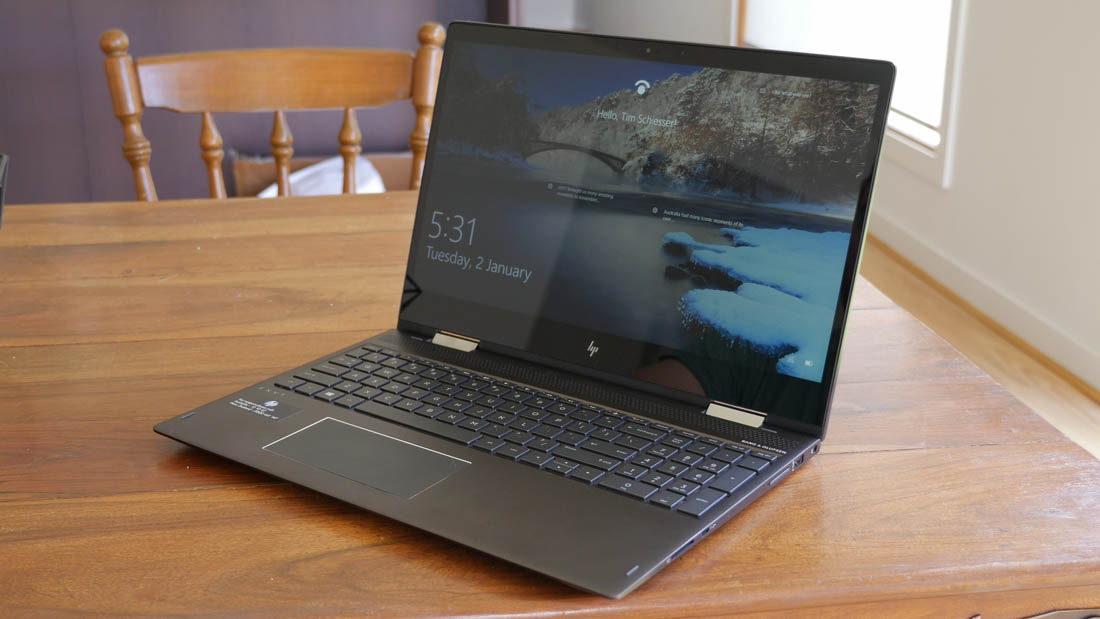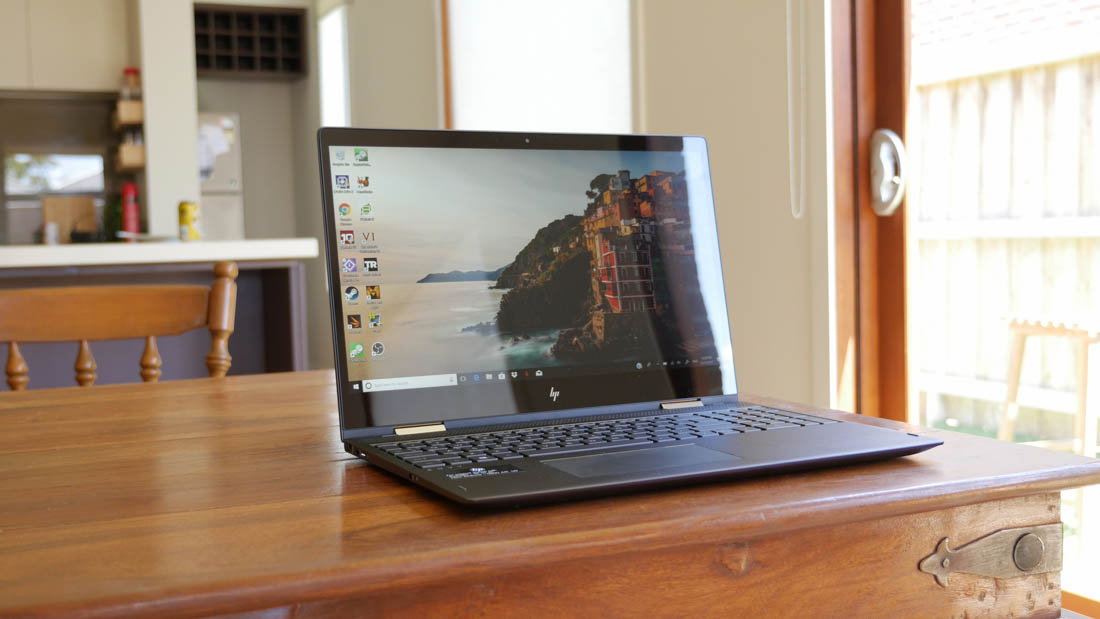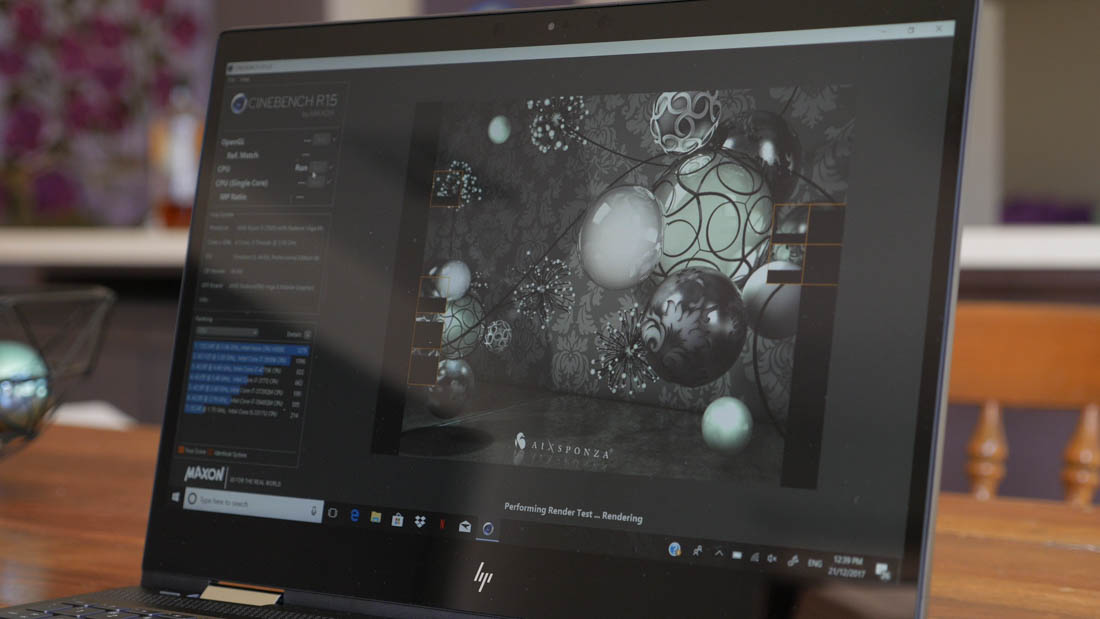HP

Today we’re taking a look at the very first Ryzen Mobile laptop to hit the market: the HP Envy x360. This is the same laptop we used to benchmark the Ryzen 5 2500U mobile APU a couple of weeks ago, pitting it against Intel’s 8th gen Kaby Lake Refresh CPUs in a battle of CPU and GPU power.
While Ryzen Mobile is super interesting, the Envy x360 is worth talking about in its own right, especially as AMD enthusiasts or really anyone looking for decent laptop graphics might be interested in buying one of these systems. It’s also available in an Intel version, but Ryzen is the star of the show here so it will be the focus of this review.

The Envy x360 is HP’s mid-tier 15-inch convertible laptop, which sits below the Spectre x360 that’s available in 15 and 13 inch sizes. As a convertible, it has a 360-degree hinge that allows you to use it in various modes, like a tablet, a tent, a stand or just a standard laptop. It’s sometimes handy to have convertible functionality, though at this size, using the system as a tablet is a bit difficult, so you’ll probably stick to the laptop mode for the most part.
The display is a typical 15.6-inch 1080p IPS LCD touchscreen, and there’s a standard range of configurable hardware: 8GB up to 16GB of DDR4 RAM, 256GB through to 1TB SSDs plus 1TB hard drives, and a rather small 55.8 Wh battery (more on that later). The processor, in the AMD model at least, is a Ryzen 5 2500U without additional discrete graphics.

If you opt for the Intel variant you’ll have the choice between a Core i5-8250U or Core i7-8550U, either with or without discrete Nvidia GeForce MX150 graphics. This is a typical hardware combination for 15-inch laptops, and it’ll continue to be the main competitor for Ryzen Mobile with its powerful integrated graphics in this form factor. Unfortunately, HP hasn’t provided me with the Intel model so I don’t have any data for this modern discrete GPU combination just yet.
And a quick note on price, the base Intel model is currently available for $700, while the Ryzen Mobile variant costs $750. If you’re after the Intel + MX150 combo, that’ll set you back $800 for otherwise equivalent hardware, which makes Ryzen Mobile a bit cheaper.

And a quick note on price, the base Intel model is currently available for $700, while the Ryzen Mobile variant costs $750. If you’re after the Intel + MX150 combo, that’ll set you back $800 for otherwise equivalent hardware, which makes Ryzen Mobile a bit cheaper.

While the Envy x360 isn’t a top-tier laptop price wise, the build quality is excellent. In many ways it rivals the Spectre, HP’s super slim 13-inch notebook, which I really liked when I reviewed it a while back. HP has used a combination of metal on most surfaces with a subtle brown tinge, along with the glossy glass protecting the display and grey-toned keyboard and trackpad. When paired with minimalist branding like the new HP logo and subtle Envy text, this laptop looks great and feels sturdy.
Despite the size and weight of the display assembly, the 360-hinge is strong and allows fluid movement. I love deliciously slim bezels on laptops, but HP hasn’t quite nailed it on the Envy x360 like they did with the Spectre x360.
It feels like there’s a bit of wasted space here, although I guess HP has to offer a few sweet bonuses for those that fork out more cash for the Spectre x360. One thing HP does fit in the bezels is a Windows Hello camera for quick facial recognition, which as a quick aside seems to be getting quicker and more accurate each time I use the tech on a new device.

It feels like there’s a bit of wasted space here, although I guess HP has to offer a few sweet bonuses for those that fork out more cash for the Spectre x360. One thing HP does fit in the bezels is a Windows Hello camera for quick facial recognition, which as a quick aside seems to be getting quicker and more accurate each time I use the tech on a new device.

Let’s talk ports; the most boring but one of the most crucial aspects to a laptop. The Envy x360 does reasonably well here, with two USB 3.1 gen 1 Type-A ports on each side, along with a USB 3.1 gen 1 Type-C port. No, this isn’t a Thunderbolt 3 port, as Ryzen Mobile doesn’t support Thunderbolt, not that it matters too much as the Intel variants of this laptop also don’t include Thunderbolt 3.
Other ports include a 3.5mm headphone jack, full-sized HDMI 2.0b, an SD card slot, and disappointingly a proprietary charging port. It would have been neat if it charged over USB-C, but it can’t.

Other ports include a 3.5mm headphone jack, full-sized HDMI 2.0b, an SD card slot, and disappointingly a proprietary charging port. It would have been neat if it charged over USB-C, but it can’t.

Oh and as an interesting aside, the USB-C port on this laptop is capable of DisplayPort output via an adapter even though it’s not Thunderbolt. The curious thing is the Ryzen variant supports DP 1.4 while the Intel version supports just DP 1.2, which means this Ryzen model can drive 5K 60 Hz monitors where the Intel model cannot.
The Envy x360 includes Bang & Olufsen speakers, like many other HP laptops. Bang & Olufsen are known for making high-end speaker systems, so it always strikes me as strange that they put their brand on crappy laptop speakers like this. Seriously, these speakers are no good, and sound even worse (if that’s possible) when you disable the Bang & Olufsen Experience software setting.
Oh and as an interesting aside, the USB-C port on this laptop is capable of DisplayPort output via an adapter even though it’s not Thunderbolt. The curious thing is the Ryzen variant supports DP 1.4 while the Intel version supports just DP 1.2, which means this Ryzen model can drive 5K 60 Hz monitors where the Intel model cannot.
The Envy x360 includes Bang & Olufsen speakers, like many other HP laptops. Bang & Olufsen are known for making high-end speaker systems, so it always strikes me as strange that they put their brand on crappy laptop speakers like this. Seriously, these speakers are no good, and sound even worse (if that’s possible) when you disable the Bang & Olufsen Experience software setting.
For starters, there’s nothing inherently wrong about the tech used here: I’ve seen plenty of 15.6-inch 1080p IPS LCDs that perform well. This panel has good viewing angles and a decent enough resolution, so I guess that’s something. Unfortunately, though, brightness is very weak with a peak output of just 217 nits, well below standard. Contrast is good at 1500:1, but that’s not worth much when the display itself can’t get that bright.
Tim Schiesser
The Envy x360 includes Bang & Olufsen speakers, like many other HP laptops. Bang & Olufsen are known for making high-end speaker systems, so it always strikes me as strange that they put their brand on crappy laptop speakers like this. Seriously, these speakers are no good, and sound even worse (if that’s possible) when you disable the Bang & Olufsen Experience software setting.
Oh and as an interesting aside, the USB-C port on this laptop is capable of DisplayPort output via an adapter even though it’s not Thunderbolt. The curious thing is the Ryzen variant supports DP 1.4 while the Intel version supports just DP 1.2, which means this Ryzen model can drive 5K 60 Hz monitors where the Intel model cannot.
The Envy x360 includes Bang & Olufsen speakers, like many other HP laptops. Bang & Olufsen are known for making high-end speaker systems, so it always strikes me as strange that they put their brand on crappy laptop speakers like this. Seriously, these speakers are no good, and sound even worse (if that’s possible) when you disable the Bang & Olufsen Experience software setting.
For starters, there’s nothing inherently wrong about the tech used here: I’ve seen plenty of 15.6-inch 1080p IPS LCDs that perform well. This panel has good viewing angles and a decent enough resolution, so I guess that’s something. Unfortunately, though, brightness is very weak with a peak output of just 217 nits, well below standard. Contrast is good at 1500:1, but that’s not worth much when the display itself can’t get that bright.
Tim Schiesser

No comments:
Post a Comment